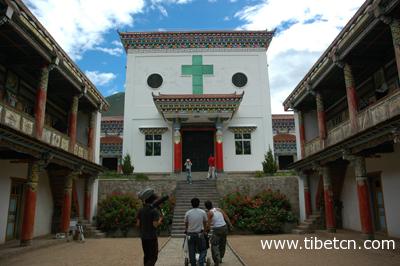(Ecns.cn) -- Every Sunday morning, Tibetan grandma Szalan takes her 9-year-old grandson, as well as a Tibetan language Bible, to attend Mass. In her village of Upper Yanjing, the only Catholic Church in Tibet has been standing since the year 1855. On the same Sunday, Szalan's son-in-law, as a Buddhist, goes to the Lama Temple near the village to chant sutras.
Unusual as it may sound, this is typical life for local Tibetan families in Yanjing, a town seated at the point where Yunnan, Sichuan, and Tibet meet. Here in the town, family members under the same roof hold various religious beliefs. Tibetan Buddhism peacefully coexists with Catholicism as well the Dongba religion.
Tea-horse market opened the window to outer world
Yanjing, meaning salt wells in Chinese, was named because of its abundant salt resources. Located in southeast Tibet, the town was the first stop on the Tea Horse Road from Sichuan Province to Tibet.
The Tea Horse Road was an ancient trade route that thrived since the Tang Dynasty (618-907) until the modern 1940s. Traders imported tea and exported fine horses from Sichuan and Yunnan Provinces into Tibet on this legendary trail.
As horse caravans stopped on their way to Lhasa for a rest in Yanjing, the town became busy as well. Researcher Mu Jihong from Yunnan University told China News Weekly that the people who lived along the road from Sichuan to Tibet didn't suffer any language barriers because of the traders, who carried not only commodities but also different cultures along the Tea Horse Road.
Multiculturalism in Yanjing
Mu also explained that, usually, horse saddles used by traders of the Bai ethnic group in Yunnan are stiff, while in Tibet, people prefer soft ones. However, in Yanjing both styles are commonly seen.
"This is a typical phenomenon of cultural mixing," said Mu, who leads the studies on the Tea Horse Road in his institution. According to the scholar, traders commuting on the road would perform Yunnan Huadeng opera for the local Tibetans when they got there from Yunnan, while Tibetan traders entertained Yunnan residents with Xianzi, a three-stringed plucked Tibetan instrument. Through the road, some craftsmen brought developed technologies into Tibet with them. In the 17th century, missionaries entered Tibetan via the Tea Horse Road and built Tibet’s only Catholic Church in Yanjing.
Among the current population of Yanjing, a quarter of them are of the Naxi ethnic group, followers of Tibetan Buddhism, and the rest are mostly Tibetans who believe in Catholicism.
Even the Church bears signs of cultural mixing with an eye-catching cross on the top of a Tibetan style building.


















